Samsung Galaxy Tab 2 7.0 Review
Samsung Galaxy Tab 2 7.0
An Android tablet available for under £200.
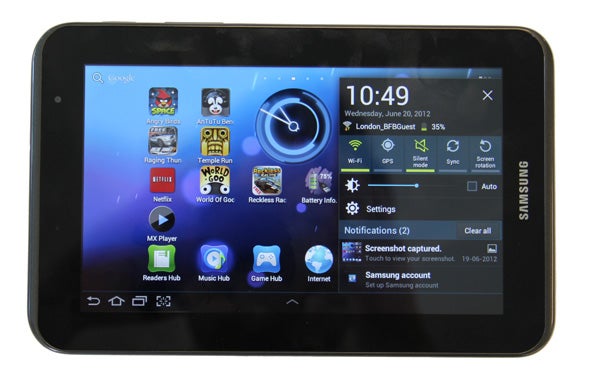
Verdict
Pros
- Low-end models good value
- Expandable memory
- Decent performance
Cons
- Limited screen resolution
- Games support slightly limited
Key Specifications
- Review Price: £199.99
- Dual-core 1GHz CPU
- 1GB RAM
- 7in 1,024 x 600 pixel screen
- microSD slot
- 8/16GB memory
Design
With its gaze set on the budget buyer who doesn’t want to make do with a cheapo no-name tablet, the Samsung Galaxy Tab 2 7.0 doesn’t have a particularly dynamic or interesting design. Its inch-thick screen bezel looks chunky, it has a plastic rear and while hardly rotund at 10mm thick, its form feels designed to be comfortable rather than razor-thin.
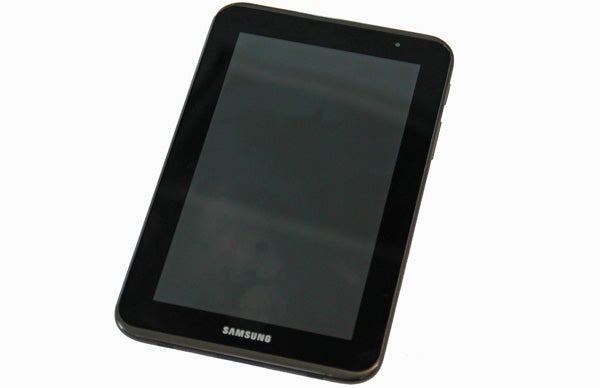
It feels much better-made than the vast majority of budget tablets we’ve tested, though. In making the plastic rear plate non-removable, Samsung has been able to fashion a solid and strong-feeling slab. And while it doesn’t have that cool touch of metal, it has been textured to afford it a similar feel on the finger to anodised aluminium.
The front of the Samsung Galaxy Tab 2 7.0 is glass. It’s not Gorilla Glass as far as we can tell, but feels just the same under the finger and avoids the “oil slick” effect that plagued many Samsung Galaxy Tab 10.1 tablets last year. 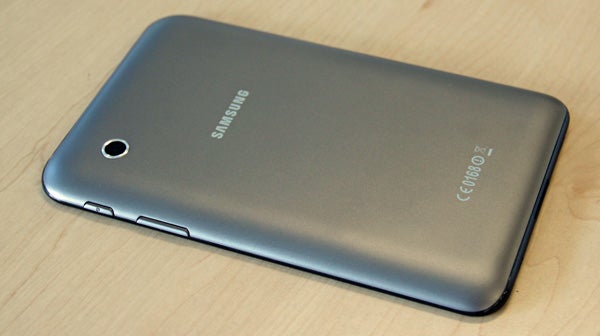
One of the best things about a 7in tablet is that you can hold it in one hand without developing muscles in weird places within your forearm. At just 344g, the Galaxy Tab 2 7.0 feels right at home in one mitt – and in this situation the generous bezel comes in handy, giving you space to rest your thumb without obstructing the screen. It’s almost as if professional designers produced this thing…
Connectivity
As with the other tablets in the Galaxy range, the Samsung Galaxy Tab 2 7.0 keeps its on-body connections simple. It features what’s arguably the most important, though – a plastic flap on its right edge covers a microSD card slot. Its 16GB of internal memory (8GB version also available) is already reasonably generous, but this slot makes upgrading quick, cheap and painless.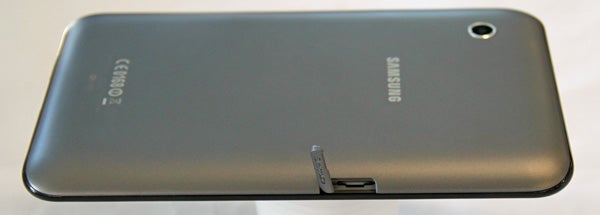
The 3.5mm headphone jack sits on the top edge, right next to a teeny pinhole microphone. Its speakers are – sensibly – placed poles apart on the bottom edge – and there are two of them. Getting stereo sound in a tablet is a neat extra, but it’s not particularly well-executed here. When held in landscape, while watching a movie for example, all sound comes from the right side, providing zero sense of stereo image. 

The level of volume these teeny speakers can produce is reasonable, but sound quality is not a match for the iPad. It has decent body and scale, but little fidelity or richness.
Between the speaker duo sits the proprietary adaptor socket, used to both charge the tablet and transfer data to its brainbox. The positive side of using this dock is that it makes producing the supportive desktop and car docks (available, but not included) easy, but also ensures losing the cable is more of a problem – it proprietary sockets are a bit of an irritation generally. The tablet battery doesn’t charge when you plug the cable into a computer, either. 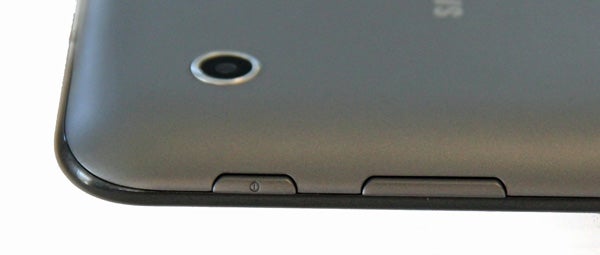
The Samsung Galaxy Tab 2 7.0 offers both MTP and PTP transfer modes, which tells your computer that it’s either a media player or camera when plugged-in. As long as you’re not running an ancient version of Windows (or any version of Mac OS) you can drag and drop files directly onto the memory using Windows Explorer. Testing with a Mac, it seems Samsung sync software Kies is needed to transfer files.
Android 4.0 Ice Cream Sandwich
The Samsung Galaxy Tab 2 7.0 runs Android Ice Cream Sandwich. This is the upgraded version of Honeycomb, which was the first tablet-focused version of Google’s operating system.
Samsung has dropped-in some of its own TouchWiz touches too – this is Samsung’s proprietary user interface – and in all honesty it doesn’t look all that different to last year’s Honeycomb-based tablets. 
Whatever way you hold the Samsung Galaxy Tab 2 7.0 – landscape or portrait – on the home screen there’s shortcut and notifications bar at the bottom of the screen, and links to Google search and the apps menu up top.
Although reasonably intuitive, this is a layout that feels more at home on a 10in tablet than a smaller one like this. When held portrait, it feels as though you should be able to access most features with your two thumbs – but you can’t thanks to Google’s obsession with spreading links across the screen. And having the toolbar constantly sitting at the bottom of the screen can make the display feel a little cramped – a feeling you don’t get with 10.1in Android tablets. 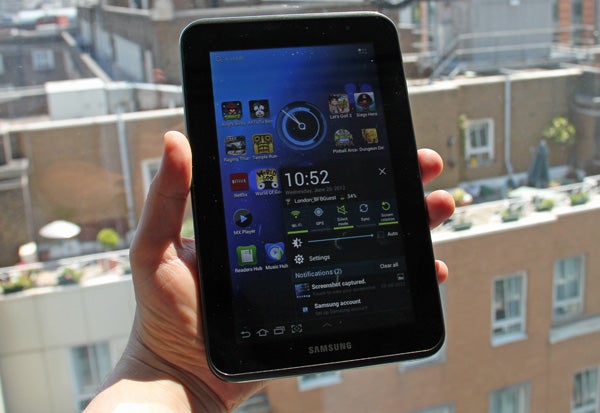
It’s almost enough to make you miss the days of Android 2.3 Gingerbread tablets running what’s essentially a phone OS, like the original 7in Samsung Galaxy Tab. We say almost because the benefits of a proper tablet OS still far outweigh the niggles – key among them having tablet-optimised apps to play with.
TouchWiz Extras
Samsung UI TouchWiz doesn’t dramatically alter the DNA of the Android OS, but it does tack some neat extras on. Among the most front-facing is the screenshot-taking button on the home screen toolbar. Previous versions of Android have made it bafflingly difficult to take a screenshot, and we find it a most welcome addition. 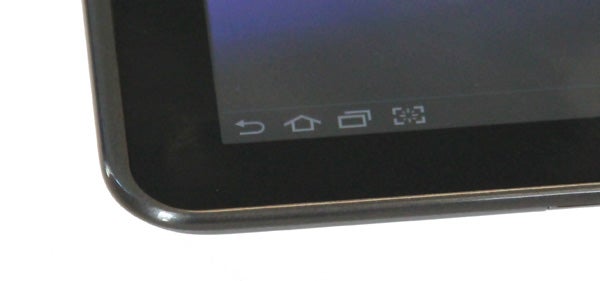
Samsung AllShare also comes pre-installed. This is the manufacturer’s own DLNA interface, and it’s consistent across many home gadgets including TVs, phones and Blu-ray players. It lets you stream media over Wi-Fi and – as long as each end is AllShare compatible – takes most of the fiddliness out of the pairing process.
TouchWiz offers its own keyboard, too. It’s not particularly pretty, but it makes typing quick and accurate on the 7in screen, and if you really don’t like it, putting a replacement in its stead isn’t difficult.
Apps and Games
Activities that benefit most from the large screen of a tablet, over a smaller smartphone display, are things like web browsing, video-viewing and email-sifting.
Enriching browsing, Adobe Flash support is in, and the 7in form is a good size for reading web pages. With a good web connection pages render fairly quickly, and the responsive capacitive touchscreen makes whizzing around them a joy. A higher-resolution display would make reading more comfortable, but it’s like to be a while before we see super high pixel density tablets do the limbo under the £200 barrier.
Games and apps suffer from the lower resolution a little too, but not primarily because of a lack of pure pixel density. It’s more an issue of compatibility and optimisation.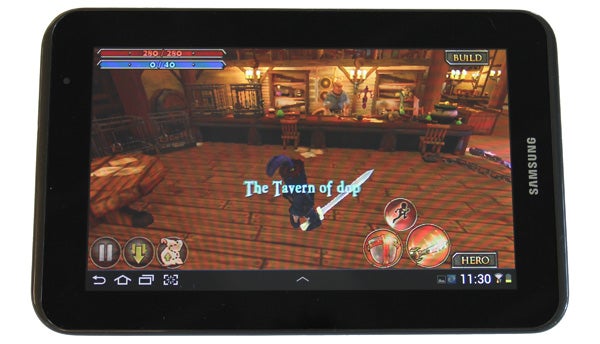
The Samsung Galaxy Tab 2 7.0 has full access to the Google Play app store and plenty of its hundreds of thousands of apps and games. However, with an unusual 1,024 x 600 pixel resolution, many apps and games are not fully optimised for the tablet, and some are not compatible at all.
For example, in the popular Unreal Engine 3-powered Dungeon Defenders Second Wave, the graphics appear to be upsized from those of a lower resolution device (most likely 800 x 480 pixels or similar). When using most 1,280 x 800 Android tablets, such as a Samsung Galaxy Tab 10.1, they’re nice ‘n’ crisp.
With high pixel density devices flavour of the month, it is unlikely that many more devices of this resolution will be made. And therefore developer support is unlikely to increase much. In fairness, most games look and play just fine.
It’s a pity, though, because the Samsung Galaxy Tab 2 7.0 packs a decent punch for an affordable tablet. In the AnTuTu benchmark it scored 5220 points. As a point of reference, last year’s similarly-priced, dual-core Time2touch HC701A scored just 2870 – and that seemed pretty zippy at the time. The Tab’s CPU is a TI OMAP 4430 dual-core 1GHz model with 1GB of RAM, roughly comparable with last year’s top-end Android tablets.
Screen
Using Samsung’s PLS display technology, the Galaxy Tab 2 7.0 offers decent viewing angles and image quality. PLS is Samsung’s own take on IPS, the core screen tech used in Apple’s iPad tablets.
It’s not quite on-par with the best of IPS though, with significant contrast shift creeping in when the display is tilted in one particular angle. As it’s not an angle you’d normally view the tablet from, though, it’s not a big problem.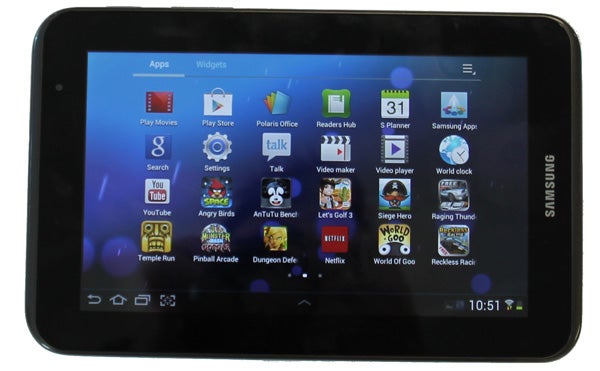
A deficiency that’s much more noticeable is screen resolution. With a 1,024 x 600 pixel screen, the Tab 2 7.0 offers the same pixel count as the original Samsung Galaxy Tab and the comparable Acer Iconia A100. Although it offers slightly higher pixel density than the first and second iPads, with 169dpi, you can easily discern individual pixels if you get reasonably up-close – when reading, for example.
Video Compatibility
It’s somewhat-less noticeable with less high-contrast images, such as those of movies. And, in the Samsung tradition, video codec support is pretty good. MKV support is included – handy for video downloads – although unusually it failed to play some of our less challenging test files. It supports Xvid and DivX, but stumbled over one of our SD DivX tests, suggesting some more software optimisation is needed. A patch perhaps, Samsung?
There’s not need to wait around, though, as third-party apps can use software rendering to play anything not supported natively by the tablet.
Battery Life
Tasked with playing a looping SD-quality video at 50 per cent screen brightness, with wireless turned off, the 4000mAh battery lasted for six and a half hours – pretty close to the claimed figure of seven hours. While it outlasts most tablets of its size, and most tablets under £200, this is lower performance than premium 10.1in tabs and well below the iPad’s 10-plus hours.
Cameras
The Samsung Galaxy Tab 2 7.0 has two cameras. There’s a VGA user-facing camera for video chat and a 3.2-megapixel main sensor that captures photos at up to 2,048 x 1,536 pixel resolution. 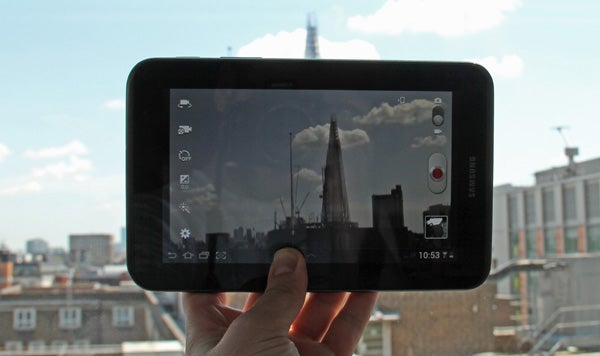
It’s a basic affair. It doesn’t have autofocus, lacking any control over the subject of your shots, and there’s no flash. The only extras beyond the stripped-back basics of sepia/black and white filters you’re treated to are Smile Shot and a panorama mode. Image quality is fairly poor and video capture maxes out at 720p.
Value
Starting at £199.99 for the 8GB version, the Samsung Galaxy Tab 2 7.0 is much cheaper than most of Samsung’s tablets. It’s also much better than the vast majority of tablets we’ve tested selling at under £200. Lacking a flashy design and top-end specs, its higher-end models, such as the more-expensive 3G editions, don’t make a great deal of sense. However, as an alternative to smaller £150-250 tablets like the BlackBerry PlayBook, HTC Flyer and Acer Iconia A100, it’s the pick of the bunch.
Verdict
The Samsung Galaxy Tab 2 7.0 isn’t out to prove a grand point. This isn’t the Galaxy Note, or the dazzling Tab 7.7. However, it is one of the very best tablets you can buy for under £200. With a dual-core 1GHz processor and relatively low-density 1,024 x 600 resolution screen, it’s hardly cutting edge but performance is solid and build is good. The one lingering concern is that the screen resolution ensures games optimisation and support isn’t up there with the best.
How we test tablets
We test every tablet we review thoroughly. We use industry standard tests to compare features properly and we use the tablet as our main device over the review period. We’ll always tell you what we find and we never, ever, accept money to review a product.
Trusted Score
Score in detail
-
Performance 8
-
Value 8
-
Design 7
-
Screen Quality 8
-
Features 8
-
Battery Life 7


